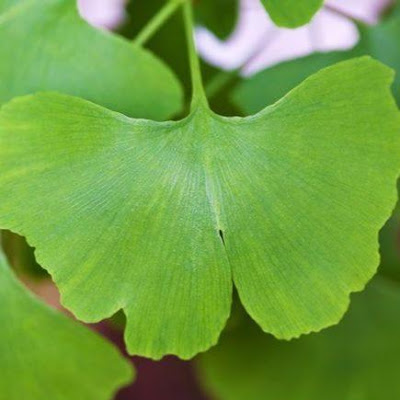Did you know that Ginkgo trees have survived as a species virtually unchanged for 200 million years? They have and the patterns on their leaves may help scientists decipher ancient climates. Here's the story from the Associated Press and a video:
(Photo: A Ginkgo leaf. Credit: https://www.plantingtree.com/)
Fossil leaves may reveal climate in last era of dinosaurs
WASHINGTON (AP) — Richard Barclay opens a metal drawer in archives of the Smithsonian Natural History Museum containing fossils that are nearly 100 million years old. Despite their age, these rocks aren’t fragile. The geologist and botanist handles them with casual ease, placing one in his palm for closer examination.
Embedded in the ancient rock is a triangular leaf with rounded upper lobes. This leaf fell off a tree around the time that T-rex and triceratops roamed prehistoric forests, but the plant is instantly recognizable. “You can tell this is ginkgo, it’s a unique shape,” said Barclay. “It hasn’t changed much in many millions of years.”
What’s also special about ginkgo trees is that their fossils often preserve actual plant material, not simply a leaf’s impression. And that thin sheet of organic matter may be key to understanding the ancient climate system — and the possible future of our warming planet.
“Ginkgo is a pretty unique time capsule,” said Peter Crane, a Yale University paleobotanist. As he wrote in “Ginkgo,” his book on the plant, “It is hard to imagine that these trees, now towering above cars and commuters, grew up with the dinosaurs and have come down to us almost unchanged for 200 million years.” “We want to understand how the planet has responded in the past to large-scale changes in climate — how ecosystems changed, how ocean chemistry and sea levels changed, how forests worked.”
Tiny pores on a leaf’s underside are arranged to take in carbon dioxide and respire water, allowing the plant to transform sunlight into energy. When there’s a lot of carbon in the air, the plant needs fewer pores to absorb the carbon it needs. When carbon levels drop, the leaves produce more pores to compensate.
Today, scientists know the global average level of carbon dioxide in the atmosphere is about 410 parts per million – and Barclay knows what that makes the leaf look like. Thanks to the Victorian botanical sheets, he knows what ginkgo leaves looked like before humans had significantly transformed the planet’s atmosphere. VIDEO: https://youtu.be/qJxZF77ltnU


No comments:
Post a Comment